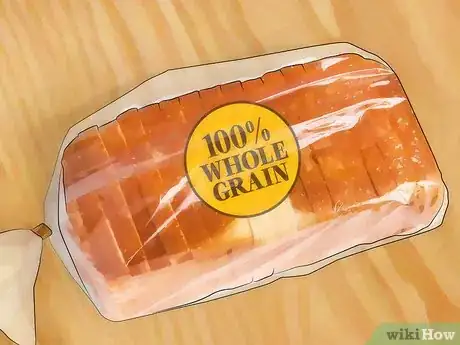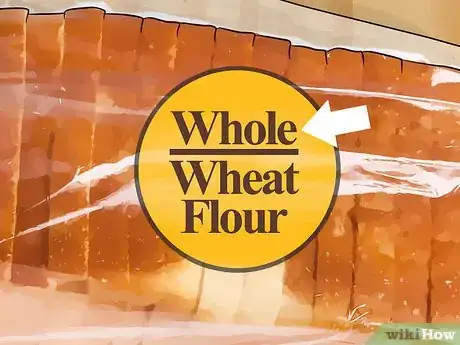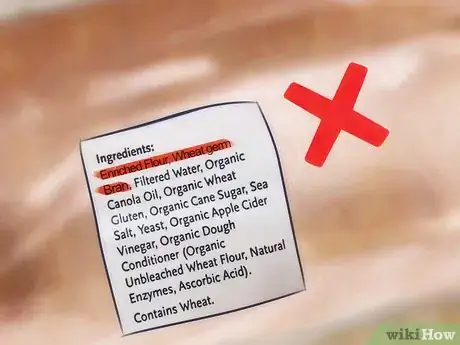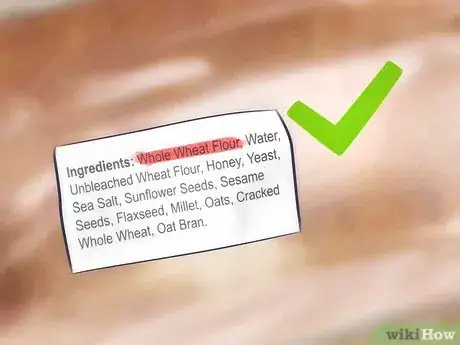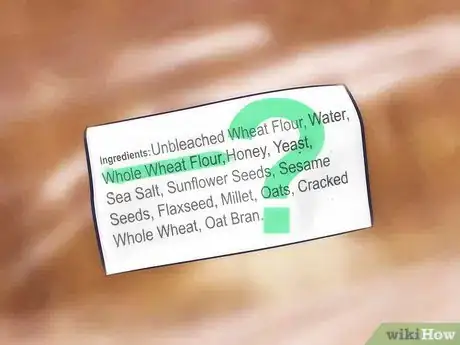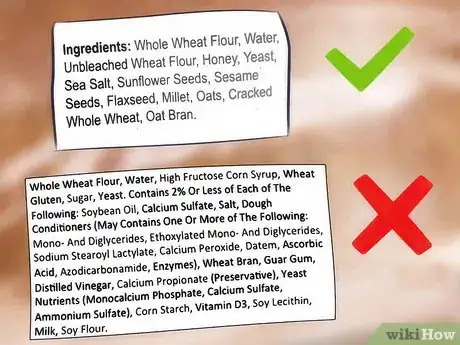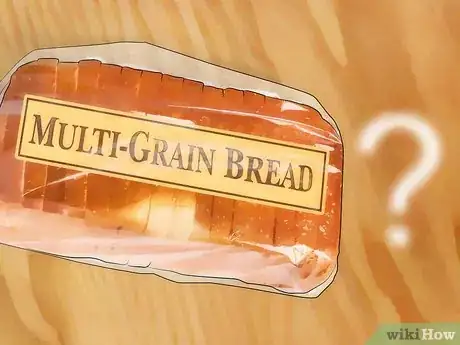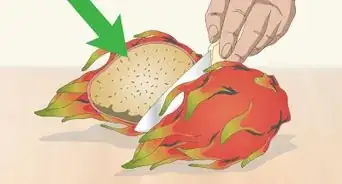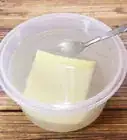This article was co-authored by wikiHow Staff. Our trained team of editors and researchers validate articles for accuracy and comprehensiveness. wikiHow's Content Management Team carefully monitors the work from our editorial staff to ensure that each article is backed by trusted research and meets our high quality standards.
This article has been viewed 87,776 times.
Learn more...
In order for a product to claim that it is “100% whole wheat,” it must only contain whole grains and provide consumers with a full serving of whole wheat per one recommended serving size. When you shop for 100% whole wheat products, don’t be fooled by misleading claims, colors, and appearances. Instead, always thoroughly investigate the bread’s packaging before you purchase a loaf—look for the Whole Grains Council’s stamp of approval and always read the label and ingredient list carefully.
Steps
Decoding the Label
-
1Look for the “100% Whole Grain” Stamp. In 2005, the Whole Grains Council began to release products that contained a “100% Whole Grain” stamp. The stamp allows consumers to identify whole grain products quickly and reliably. If a product contains this stamp, the consumer can rest assured that the product:
- Contains at least a full serving of whole grain per recommended serving size.
- Contains only whole wheat.
- Products that carry the “Whole Grain” stamp must contain at least half a serving of whole grain per recommended serving size.[1]
-
2Understand the term "whole grain." Whole wheat is just one type of whole grain. While searching for whole wheat bread, you may come across products labeled "Whole Grain." These breads may contain whole wheat, a different type of whole grain, or a combination of several whole grains.[2] Read the label to determine if the product is made from 100% Whole Wheat.Advertisement
-
3Remain skeptical of products that may contain whole grains. As grain kernels are processed, parts of the grain are removed. If the label does not include the word “whole” in front of a grain, the entire kernel may not be present in the product. When you shop for whole wheat bread, remain wary of products with the following words on their labels:
- Wheat or wheat flour
- Semolina (purified endosperm of durum wheat common in pastas and cereals)[5]
- Durum wheat (dense wheat commonly used in pastas and cereals)[6]
- Organic flour
- Stone ground
- Multigrain (this term indicates that the product contains multiple types of whole grains ‘’’and/or’’’refined grains.[7]
-
4Avoid products that list parts of the grain as ingredients. Throughout the refinement process, the three parts of the wheat kernel are separated. Each part of the kernel is repurposed and sold as its own product. Avoid products that list parts of the kernel on its labels. These terms include:
- Enriched flour: when wheat flour is refined into white flour, the bran and germ are stripped away, leaving only the endosperm.
- Bran: this is the outer layer of the kernel.
- Wheat germ: this is the part of the kernel responsible for new plant growth.[8]
Reading the Ingredient List
-
1Look for products that list whole wheat as the first ingredient. Food companies must list their ingredients in descending order of weight. The most prevalent ingredient is always the first item listed. If you are searching for a 100% whole wheat product, the first ingredient listed should be “Whole Wheat Flour,” “100% Whole Wheat Flour,” or “Wholemeal Flour.” No other type of flour should appear in the ingredient list.
- Wheat flour, unbleached wheat flour, multigrain, enriched, and stone-ground wheat flour are alternative ways of saying “refined white flour.”[9]
-
2Be skeptical of products that list whole wheat second. If whole wheat is the second item on the ingredient list, there is a high chance that whole grains account for a majority of the ingredients. However, this is not always the case. When whole wheat is listed second on the ingredient list, the bread may contain between 1% to 49% of the grain.
- When in doubt, always choose a product that lists whole wheat first.[10]
-
3Note the length of the ingredient list. The only ingredients required to bake delicious bread are flour, water, yeast, salt, and a pinch of sugar. Bread manufacturers add additional ingredients to their bread to enhance their product’s taste, texture, and shelf-life. If you are trying to purchase less-processed bread, shop for items that have a short ingredient list with identifiable ingredients.[11]
Avoiding Marketing Traps
-
1Do not buy bread based on its color. A common misconception regarding bread is that the color of the loaf is directly related to the nutritional value of the product—the darker the loaf, the healthier the bread. This is not always the case, however. Always read the ingredient list to determine if a product is truly nutritious and made of whole wheat or if it simply contains artificial coloring agents.
- Many dark loaves, such as pumpernickel and rye, are often made with enriched flours and receive their dark hues from molasses or caramel.
- White bread is not always unhealthy. Many manufacturers are now producing white breads made from white whole wheat flours.[12]
-
2Do not buy bread based on descriptive words. Bread companies use certain phrases to make consumers believe that their product is more nutritious than it truly is. These phrases often include the following words: “country,” “home,” and “harvest.” Since these phrases are not regulated by the FDA, bread companies may deceptively depict the production process.
- Don’t let these words prevent you from scanning the ingredient list.[13]
-
3Do not assume that multigrain bread is made with whole grains. Multigrain sounds incredibly nutritious, but the term’s vagueness makes it rather deceptive. A multigrain product does not necessarily contain a variety of whole grains. More often than not, multigrain products only contain refined grains.
- Read the ingredient list to determine if a multigrain product contains whole or refined grains.[14]
Community Q&A
-
QuestionMethod 2, Step 3, has a green check mark next to a label that is clearly not 100% Whole Wheat. The third ingredient is Unbleached Wheat Flour, which is not Whole Wheat Flour. Is this right?
 Community AnswerMany products will use both whole wheat and unbleached wheat flour. It can be labeled whole wheat if it is not 100% whole wheat. The article was suggesting that the whole wheat flour being first on the ingredient list would make it the most used ingredient. If unbleached wheat flour was first and whole wheat flour was third, you should be skeptical.
Community AnswerMany products will use both whole wheat and unbleached wheat flour. It can be labeled whole wheat if it is not 100% whole wheat. The article was suggesting that the whole wheat flour being first on the ingredient list would make it the most used ingredient. If unbleached wheat flour was first and whole wheat flour was third, you should be skeptical.
Warnings
- You will not be able to determine whether your wheat bread is 100% simply by appearance, texture or taste. Some 100% whole wheat loaves were developed with the sole intent of providing 100% whole wheat nutrition while maintaining the mild taste and soft texture of enriched wheat options.⧼thumbs_response⧽
References
- ↑ http://wholegrainscouncil.org/whole-grains-101/identifying-whole-grain-products
- ↑ http://wholegrainscouncil.org/whole-grains-101/definition-of-whole-grains
- ↑ http://www.womansday.com/health-fitness/nutrition/tips/a5521/what-to-look-for-when-buying-bread-116101/
- ↑ http://wholegrainscouncil.org/whole-grains-101/identifying-whole-grain-products
- ↑ http://www.austinpasta.com/what-is-semolina/
- ↑ http://www.ndwheat.com/buyers/?ID=295
- ↑ http://wholegrainscouncil.org/whole-grains-101/identifying-whole-grain-products
- ↑ http://wholegrainscouncil.org/whole-grains-101/identifying-whole-grain-products
- ↑ http://www.womansday.com/health-fitness/nutrition/tips/a5521/what-to-look-for-when-buying-bread-116101/
- ↑ http://wholegrainscouncil.org/whole-grains-101/identifying-whole-grain-products
- ↑ http://www.womansday.com/health-fitness/nutrition/tips/a5521/what-to-look-for-when-buying-bread-116101/
- ↑ http://www.berkeleywellness.com/healthy-eating/food/article/how-buy-bread
- ↑ http://www.berkeleywellness.com/healthy-eating/food/article/how-buy-bread
- ↑ http://www.berkeleywellness.com/healthy-eating/food/article/how-buy-bread
